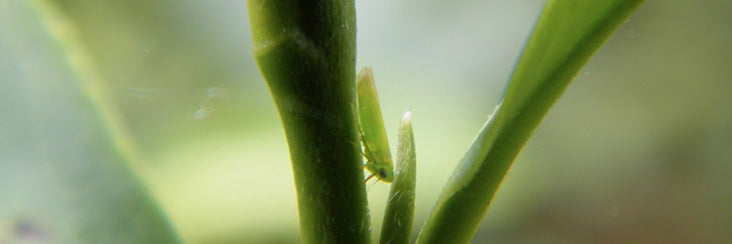
Shan Lin Xi High Mountain Concubine Oolong Tasting Notes | Eco-Cha Tea Club
Pictured above is the Little Green Leafhopper (小綠葉蟬), the tiny insect that is responsible for the creation of Concubine Oolong Tea. It's a bit of Nature's magic at work. Only about 0.5 cm in length, this "mini grasshopper" loves to feed on the sap of tender tea leaf buds. Bug-bitten Tea (as it is called in Taiwanese), has a distinct honey-like note in its flavor profile. Concubine Tea is made from bug-bitten tea leaves that are processed in a similar fashion to traditional Dong Ding Oolong Tea. The name was chosen in reference to the original, or at least the most renowned form of bug-bitten tea — Oriental Beauty.

This crop of bug-bitten tea leaves was harvested last summer from the Shanlinxi High Mountain Tea growing region in Nantou, Taiwan. In recent years, more and more farmers are refraining from administering any pesticides during the summer growing season, purposely allowing the Leafhopper to work its magic. However, if it is a rainy growing season, the chemical compounds in the leaf get diluted, and the "bug-bitten effect" is lost. This year has been an exceptionally rainy summer, so no one is really expecting to reap the benefits of the Green Leafhopper. Luckily, a friend bought an entire crop of bug-bitten leaves, and has been slowly roasting them in small batches until now — offering us the opportunity to share this batch with our tea club members.

The roasted flavor of this batch is quite evident, similar to a traditional Dong Ding Oolong. In addition to this, however, is a flavor note that is almost impossible to isolate from the overall profile, but really adds a distinctive aspect. The flavor effect gotten from bug-bitten leaves is a combination of a honey note with a much more bold character. Put simply, this tea has a strong flavor that is balanced and mellowed by the roasting effect. It requires some attention given to the amount of tea leaves used, so as not to over brew. But when brewed properly, the hearty character coming from the inherent bitter/astringent quality of tea combined with a flower honey bouquet, along with a hint of roasted smokiness provides a particularly rich, hearty flavor profile!

Lots of sunlight and sufficient rain in the summer provide a fast growing season for the tea plants. This is evident in the longer stems and larger leaves on the new growth that is harvested. So the dried leaves are bulkier and larger than other seasons, and the brewed leaves expose the long stems of a summer crop. Bug-bitten tea requires more attention and finesse to process, not only due to the bug-bitten factor, but also because it is more difficult to evenly deplete the leaves of their water content during the oxidation and drying phases. Like Oriental Beauty, the name is an ironic twist on the outer appearance of the leaves that belie the "inner beauty" of the tea leaves.

So we suggest that you take your time in getting to know this tea that embodies a bold and complex character. In its 21st Century incarnation, Concubine Oolong Tea is a fusion of natural farming, traditional tea making wisdom, and modern tea processing methods. Please share your experience of this unique batch of tea with all of us in the Eco-Cha Tea Club.


